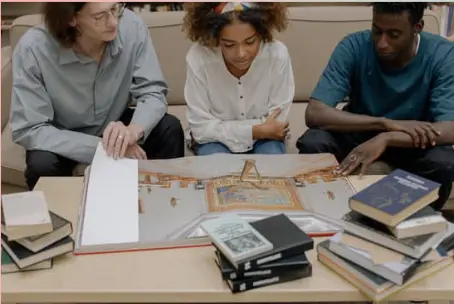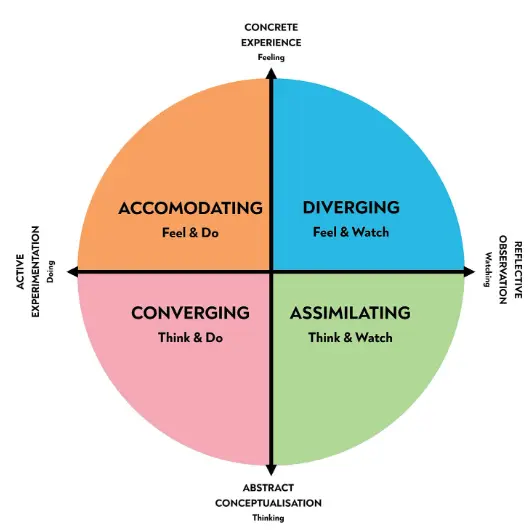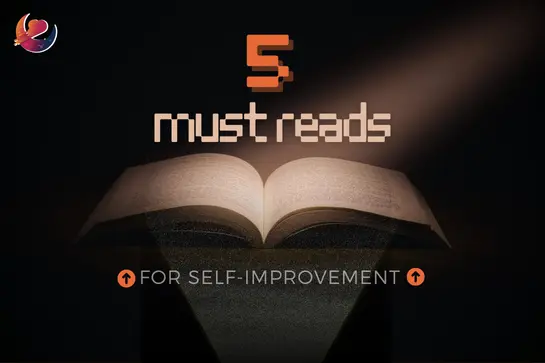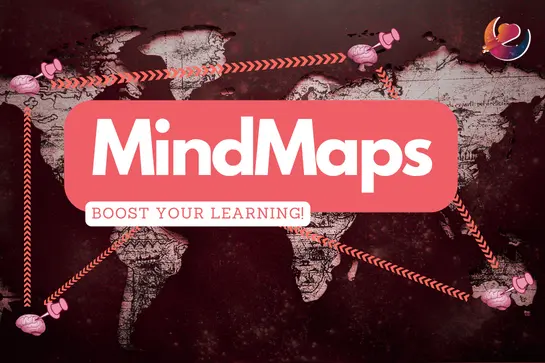By Sofia Sibila | 15th September, 2022
We all know the importance of learning in a student’s life. By learning we're able to find success in life, maybe by learning what we always wanted to or to work in our dream jobs. Knowing how important learning is, it seems funny how we never take the time to learn how to learn. Well, now that's the time!

We’ll dive deeper into Kolb's learning styles, how to find your style and some tips to approach learning for you!
The Four Stages Of Action To Learn 📖
In Kolb’s theory, there are four steps to learn that are: concrete experience, reflective observation, abstract conceptualisation, and active experimentation. They can be easily understood by feeling, watching, thinking, and doing.
Each person is a mix of two of these attributes. By finding out which attributes are essential for you you’ll be able to find a way to learn whatever you want or need. Before finding out which are your essential steps, let’s comprehend better each one of them.
-
Concrete Experience (Feeling)
The concrete experience belongs to these students that must do it by themselves to learn. From a volleyball spike to a math equation, this student must have the time to find out how it feels to do it.
-
Reflective Observation (Watching)
In the reflective observation, the student must stop and reflect on what he noticed. This kind of student will try to dissect concepts by asking questions and doing some mental exercises related to this concept.
-
Abstract Conceptualisation (Thinking)
This student must understand the meaning of this knowledge, and its structure and understand why it makes sense.
-
Active Experimentation (Doing)
These students will learn by trying by themselves and seek answers by themselves. No books nor mental planning is as useful as trying out for them.
The Four Learning Styles 📚
Now that you know a bit better about each step you can better understand what which combination of these steps stands for!
-
Diverging (feeling and watching)
Very sensitive people, these students can see things from different perspectives. . The gathering of information it’s a lot easier, and with their imagination, and problem-solving it’s easy. Another important attribute it's how they care about details.
Some key aspects of this kind of student:- Rather approach new knowledge first by watching than doing
- Nice at collecting information
- Likes personal feedback
- Try to see things from different perspectives
- Detailed people
-
Assimilating (watching and thinking)
Very logical and analytic people. This kind of student can organise information clearly and logically. Have a facility to comprehend abstract concepts. More attracted to logical theories than people and their discrepancies, these students learn through lectures, reading, and having time to analyze the piece of knowledge.
Some key aspects of assimilating students:- Logical problem solving
- Nice at understanding abstract concepts
- Need time to think
- Like ideas without practical applications
-
Converging (doing and thinking)
Like assimilating students, converging students have a facility to understand ideas and theory, but an important aspect that delimitates their similarity is that converging people take the theory and apply it to find practical results of it. People with a converging style like to experiment with new ideas, simulate, and work with practical applications.
Some key features of a converging student:- They like to see knowledge put into work.
- Manipulates knowledge to find a practical answer
-
Accommodating (doing and feeling)
The hands-on student needs the experimental approach to learning. By listening to others and trying to give a reason for this knowledge by themselves, this kind of student needs the opportunity to try, fail and try again to then deeply understand what he is doing.
Some attributes of this kind of person:- Learn doing something
- Use their gut feeling
- Hands-on people

The learning cycle and where each one of the learning it’s located.
But How Is All This Information Even Useful For You? 🤔
By having a way to analyze the best learning process for each one of us it’s a lot easier to navigate through our facilities and difficulties and understand what may be missing to turn us into better students. But firstly, it’s necessary to find out which way you learn. There are a lot of questionnaires on the internet, and I’ll leave a link for one of them by the end of this article that you can check out before reading some tips for each one of the types of learning.

1. Diverging (feeling and watching)
These students, even though have the facility into seeing things in very detail, may find trouble understanding the broad context of some subjects, not being able to use all the repertoire of knowledge necessary because they’re just
way too focused on small exceptions. To solve this problem, try to broadly pass through exercises related to the subject and try to find a pattern into what’s necessary for all the exercises to complete.
★ Knowing that you’re biased to lose yourself in small
details, take this knowledge to advantage
and try to see things broader!
★ Try to give a meaning and a background for this knowledge! Need to memorize the kinds of angiosperms? See images of these kinds, watch videos, whatever gives you
some familiarity with the subject.
2. Assimilating (watching and thinking)
You already have the easiness to understand logical ideas, so if you’re able to find this logic in more contradictory information. For example, trouble remembering all the history information for tomorrow's exams? Believe me, history is moved through some kind of logic, even if a very hidden one. After all, people tend to be irrational the same way in the same situations, you just need to find the key contributions to these actions.
★ Try to perceive the information you’re trying to improve when you’re having fun (example: while reading a book you may like, try to notice the grammar rules being applied in the book. Start small, with only one grammar rule you need
for the next exam)
★ Some subjects may carry a lot of flexibility and may seem way too chaotic to understand, but there is a logic that, even if doesn’t explain everything it may cover the majority of the knowledge you need for this literature
test. Try to find what’s essential in a book’s storytelling and save your time.
3. Converging (doing and thinking)
Do you like practical application? Then practically applicate this knowledge! Take what you like (engineering for example) and try to find out how this time period impacted the construction of houses and stuff. Do a multidisciplinary exercise!
4. Accommodating (doing and feeling)
In This one it’s a lot harder to learn abstract ideas, so try to give a realistic perspective of this subject. For example, if you have trouble with math you can graphically calculate what you’re learning and somehow connected all these weird letters with images! Doing exercises may help you a lot too, but you must be able to see how math really works. Don’t forget you don’t have to know everything, just enough to pass your exams.
⭐ Check Out This Interactive Questionnaire To Find Out Your Style! 😄
👉Click Here





Forgot password?
Close message
Subscribe to this blog post's comments through...
Subscribe via email
SubscribeComments
Post a new comment
Comment as a Guest, or login:
Connected as (Logout)
Not displayed publicly.
Comments by IntenseDebate
Reply as a Guest, or login:
Connected as (Logout)
Not displayed publicly.